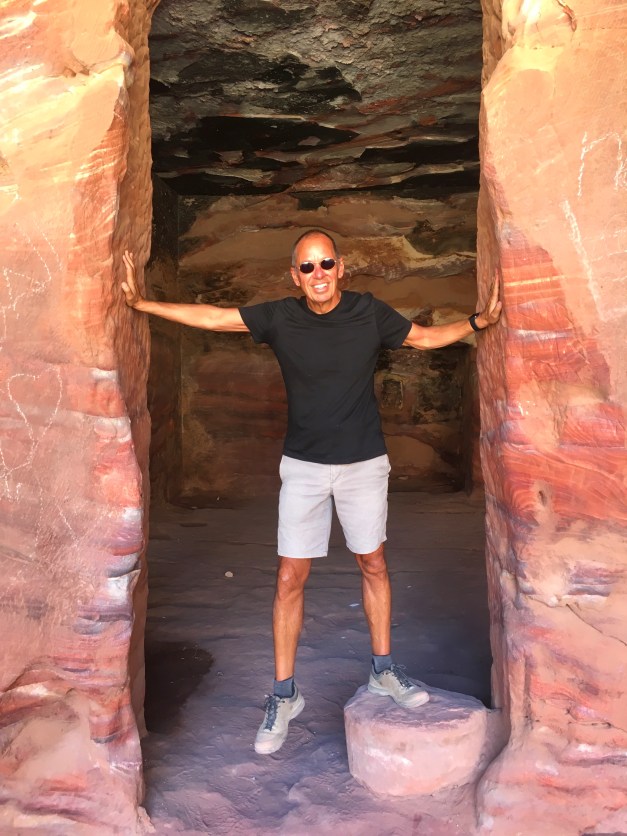Petra is stunning. A UNESCO World Heritage Site and Jordan’s most-visited site, it is on pretty much every list of things you have to see in the world. Mark was here 20 years ago but this was my first visit. A lot of places can seem over-rated once you get there but not Petra; it is stunning.
The quick history: Established in the late 4th century BC as capital of the Nabataeans – a nomadic Arabic people – it sat at the crossroads of various trade routes and thus flourished. The Nabataeans’ great talent was in controlling the water supply in this desert region, thus creating an artificial oasis. Through the use of dams, cisterns, and water conduits they managed the water that fell as flash floods and saved it for when it was needed. With the wealth created by trade (and selling water during droughts) the Nabataeans carved grand buildings and tombs into the sandstone rocks.
Along with the entire region, Petra came under Roman rule some 2,000 years ago. Then, as trade routes migrated more to Syria’s Palmyra in the second and third centuries AD, the city began to fade. When a devastating earthquake hit in 363 the end of Petra as a major city was at hand. Eventually the city, though still known to local Arabs, was lost to Western thought for centuries until, in 1812 a Swiss explorer was shown the site by the locals. Today it is known as one of the great sites of the ancient world.
We hiked into Petra twice. We arrived in Wadi Musa – the modern town from which one enters Petra – in time for lunch, then walked down to the entrance. We weren’t going to go in as it was too late in the day, but we wanted to check it out for the next day. When we discovered that a one-day ticket was a little over $70 and a two-day ticket was under $80, we grabbed at the chance to go in and give it a quick look. We made it as far as the Treasury – the iconic site for Petra – but we ran out of time and had to turn back before seeing more of the ruins. The nice thing about being there so late was that most of the crowds were already gone.

As you exit the deep-cut Siq the first thing you see is the Treasury, this amazing building cut into the rock 2,000 years ago
The next day we got there early in the morning – before 7:00 AM – and had that walk up the Siq (“the shaft”, a narrow gorge formed from a split in the sandstone rocks) almost to ourselves. This was living! After taking more pictures of the Treasury we continued around and then up to the High Place of Sacrifice, a key religious site for the Nabataeans with grand views over the city and surrounding mountains. A lovely woman from Seattle who was already up there told us we had to climb to the Monastery as well and then relax at a little tea tent with the most amazing views of all.
So down we went, out and around through the rest of Petra, and then up, up, and up to the Monastery, some 800 steps if the travel guides are to be believed. We were blown away when we got there, this massive 500-square-foot facade carved into the rock. While it’s called the Monastery in fact it’s more properly a temple, probably to one of the Nabataean kings who was posthumously deified.
Recalling the advise of our Seattle acquaintance, I continued up to find these view points she told us of and sure enough saw one that had named itself Best View. While Mark rested with a comfy couch and some tea in front of the Monastery I continued up to that last spot.
The view was in fact stunning, across more mountains and down 1,000 feet to the Wadi Araba, the huge flat, dry area that forms the border between Israel and Jordan. The Best View’s proprietor had set up a great little area with cushions and pillows and shade right on the very edge of the cliff. Before I could even settle in, though, this cute little cat, not yet full grown, had run over and plopped herself on my lap. And there she stayed until I laid down on the cushions and she laid down on my chest. A great hike, spectacular views, and the friendliest kitty in the whole world sitting on me purring.
I texted Mark that he had to come and, when he saw the picture of me and the cat, he did. Then it got really bizarre. As he sat down with his tea that cat jumped off my lap and climbed onto his shoulders. Where she stayed. For the longest time, just chilling and purring. Leaving those views and that cat were hard but eventually we had to be going.
So Petra was great. There was a weird thing though about Wadi Musa, the modern town on the edge of Petra. This is a major tourist destination, famous throughout the world. We expected to find interesting restaurants and good food but were sorely disappointed. It’s hard to remember the last time we were somewhere with just resolutely below average food choices. And to just rub it in, most restaurants here don’t serve alcohol. Thank god we only planned a two-night stop.
Next stop Aqaba!

As we were leaving Petra heading to Aqaba we stopped at a viewpoint where you can see the narrow Siq leading into Petra

I’m sure a guide could have told us what this room used to be, but for us it was just a magnificently colored room





























